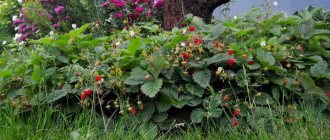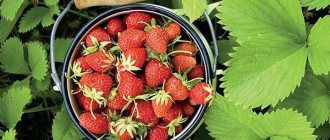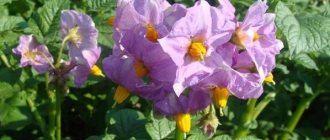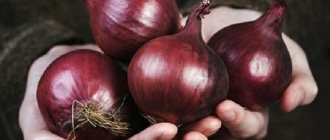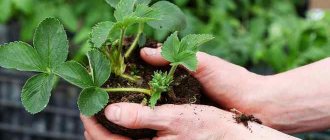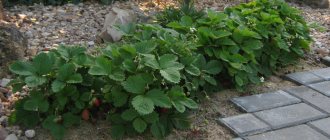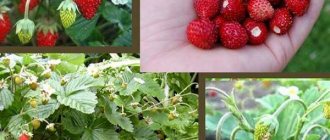Terminology
At the beginning of the story, let's understand the terminology. Many people confuse the names strawberry, strawberry, Victoria. On gardening websites, for example, you can find the following phrase: strawberries Baron Solemacher, which is completely wrong.
The differences and features of berry terminology are summarized in the following table:
| Term | Designation |
| Strawberries | The common name of a plant species. |
| Wild strawberry | The ancestor of other berries. Small conical berries grow in forests and on the edges. |
| Strawberry | A dioecious species of strawberry with round, non-conical berries and a difficult to separate pedicel. Grows mainly in meadows. |
| Garden strawberries | Cultivated varieties of berries are grown artificially in garden plots. |
| Victoria | A variety of garden strawberries. Due to its popularity, it has become a household name for many. |
| Remontant strawberry | A type of strawberry with continuous, remontant flowering and fruiting throughout the growing season. |
Description of the variety
Strawberry variety Baron Solemacher is low-growing. The maximum height of the bushes reaches twenty centimeters. The diameter depends on the year of growing season; the volume increases with each season due to growth from the roots.
The peduncles of the Baron Solemacher variety are low, so the berries are often hidden under taller foliage
The leaves are light, typically strawberry-like with sharp teeth. There are no whiskers, the flowers are bisexual, artificial pollination is needed only in protected ground or on a balcony, where there is no natural movement of air or wind.
In central Russia, the variety begins to bloom around mid-May, and the first berries can be tasted by the beginning of June, and in the south even earlier. Fruiting ends only by the end of September, and in years with a mild climate until mid-October.
The variety is frost-resistant; under snow it easily tolerates temperatures down to -35 degrees Celsius. It can also withstand heat, but during long droughts it needs watering, otherwise the yield will decrease.
Attention! The yield of the variety, according to seed producers, is 80 kilograms per hundred square meters per season.
We also note that Baron is resistant to strawberry diseases and pests.
Planting strawberries
Seedlings can be planted in beds in early June.
Selection of seedlings
To plant the Baron Solemacher variety, you need to select healthy, strong seedlings.
Their root system:
- must be fibrous with a root collar diameter of at least 6 mm;
- without damage;
- with a light green live heart;
- The roots should be juicy and not wilted.
Choosing a planting site and preparing the soil
The Baron Solemacher variety responds well to heat and sunlight, which must be taken into account when choosing a site for it. It is not recommended to plant it:
- in damp lowlands;
- in areas with close groundwater;
- in the beds where potatoes or tomatoes used to grow.
If there is high humidity in the area, then you need to prepare high beds with sides for the strawberry bushes.
Planting scheme
The optimal distance between the bushes should ensure normal aeration, as they will grow. Usually a gap of 30-35 cm is left, and up to 70 cm between the rows. We must remember that you should not bury the growing point, but you should not expose the root system of strawberries either.
Characteristics of berries
Let's move on to the description of the berries themselves. They are small, weighing 4-5 grams. The taste is sweet with a slight sourness, the flesh is dense, thanks to which they tolerate transportation well and are stored fresh for a long time.
It is not recommended to pick unripe berries - they are tasteless, bland and have little juice.
The color of the berries of the Baron Solemacher variety is bright red with a shiny tint; when cut, the pulp is white
Berry composition:
| Sugar | 7,7 % |
| Acid | 0,7 % |
| Vitamin C | 82,3 % |
Berries are used:
- fresh;
- frozen;
- prepare jam;
- compotes are cooked;
- add to jelly;
- whip up smoothies.
Advantages and disadvantages of the variety
The Baron Solemacher variety has a number of undoubted advantages, including:
Diseases of garden strawberries and their control
- good berry taste;
- long fruiting;
- high productivity;
- good keeping quality and transportability;
- unpretentiousness to growing conditions;
- frost and heat resistance;
- resistance to diseases.
Among the disadvantages, we note the need to replant the bushes to a new place after four years, as well as the importance of fertilizing to obtain a full harvest.
Agricultural technology
Reproduction
Remontant strawberries propagate in two ways:
- vegetatively by dividing roots;
- seeds.
Vegetatively
As mentioned above, the berries need to be updated at the planting site. This is due to both a decrease in the mineral reserves needed by the plant and a deterioration in the mechanical composition of the soil.
The work is usually carried out in the fall, without waiting for the end of fruiting of remontant strawberries. It is important that young plants have time to take root securely before the onset of winter frosts. If autumn is dry, you can build a temporary greenhouse over the plantings, increasing the humidity of the bed.
To transplant a plant to a new location, do this:
1. Dig up the whole plant.
2. Carefully divide the bush into individual seedlings.
3. Add the resulting “growing plants” to a new bed.
Note: An important condition is the abundance of roots on the seedling, and not the strength of its above-ground part.
The remaining bushes from the old garden bed can be given to friends and neighbors in the garden. The survival rate of plants is good, the main thing is to ensure that the roots are covered with loose soil.
Seeds
The Baron Solemacher variety is well propagated by seeds due to their high germination rate, reaching up to 95 percent.
The procedure for growing from seeds is as follows:
1. At the beginning of February, the seeds are placed in the refrigerator for two weeks for stratification.
2. Pour a layer of nutritious soil 3-5 centimeters thick into the container.
3. Apply a centimeter layer of snow on top.
4. Scatter the seeds directly on the snow.
5. Gradually melting snow seeps into the ground, taking seeds with it.
6. After the snow has completely melted, cover the container with film and wait for the entrances.
7. After 3-4 weeks, sprouts will appear; we move the containers with seedlings to a warm, illuminated windowsill.
8. In the phase of two true leaves, we dive the seedlings into separate containers.
Plants feel better in individual containers than in a common container.
Caring for seedlings consists of regular watering and one or two feedings, done two to three weeks in between.
Planting strawberries
First, let's decide on the choice of landing site. Baron Solemacher strawberries grow best in humus-rich light soils with neutral acidity. However, it is capable of developing well on clayey chernozem, provided that loosening materials are added.
The variety is very tolerant of shade; the bushes develop well in a little scattered shade from trees, although it is still better to place strawberries in areas exposed to sunlight.
It is not recommended to plant in lowlands or damp areas. In this case, it is necessary to build a high, fenced box bed and fill it with loose, permeable soil. To enrich the soil, humus, peat, ash, and compost are used.
The box gives a gain of 10-15 centimeters in planting height
Seedlings are planted in May in well-warmed soil. Place strawberries at intervals of 50 centimeters, preferably in a checkerboard pattern. With the tape planting method, the interval is kept at 30 centimeters, the distance between the tapes is 70.
The direct disembarkation process is simple:
- We mark the bed, dig small holes at the marked points.
- We water the holes.
- We remove the seedling from the container with a lump of earth.
- Place the plant in the hole and press it with soil.
- We mulch.
Note: When planting strawberries under agrofibre, first spread it on the bed and prepare holes for the seedlings.
Planting care
It is not difficult to care for strawberry plantings; the range of work comes down to the following:
- Regular watering and fertilizing.
- Loosening of plantings.
- Adding mulch.
- Removing weeds.
- Pest control.
Reproduction methods
Strawberries can be propagated in different ways - by seeds, by dividing the bush, by rosettes. Each method has certain features.
Seeds
Strawberries of this variety can be grown by seed. However, it is important to consider that seedlings will appear only after a few weeks. Therefore, planting work should be carried out in advance.
Time for sowing seeds
Seeds of this variety are planted from late February to mid-April - it all depends on the climate of the region. The later the seeds are planted, the later the harvest will be possible. The plant requires light and loose soil. It must be breathable. Usually the soil is made from garden soil and purchased soil.
Sowing in peat tablets
Peat tablets are an ideal substrate for strawberry seeds. Their key advantages include the following:
- availability of nutrients required for germination;
- no need for picking seedlings;
- the ability to grow healthy bushes;
- increased permeability to moisture and air.
It is worth considering that the tablets dry out very quickly. Therefore, it is recommended to constantly monitor their hydration.
Sowing in the soil
Planting seeds in the soil can be combined with the stratification procedure. To do this, it is recommended to do the following:
- pour the prepared soil into a plastic container with holes, and then place a layer of snow;
- place seeds on top;
- cover with film and put in the refrigerator;
- place on a windowsill near a light source;
- remove the cover and ventilate the crops daily;
- Moisten the soil from time to time, avoiding drying it out;
- provide a temperature of +20-25 degrees.
When to expect the first shoots
Approximately 2-3 weeks after planting in the ground, the first shoots appear. Mass shoots are observed after 1 month.
Dive
The sprouts are considered very tender. Therefore, it is not recommended to touch them until 4 true leaves appear. Then the seedlings can be carefully picked. To do this, they are moved into separate pots, but not buried.
Transplanting shoots to a permanent place
To ensure normal aeration, it is recommended to provide sufficient distance between the bushes. Typically, an interval of 30-35 centimeters is left between plants. The distance between rows should be 70 centimeters. It is worth considering that it is not recommended to deepen the growth point. At the same time, you should not expose the roots either.
Why seeds don’t germinate: reasons and solutions
For complete seed germination, comfortable conditions are required. Problems may be associated with the development of diseases. Treating sowing containers with antifungal compounds and disinfecting the soil will help to avoid this.
In order for the seeds to germinate, it is not recommended to neglect the stratification procedure. Also, a deterioration in germination is observed when the temperature, humidity level and lack of ventilation are not observed.
It is forbidden to allow the soil to become too dry. At the same time, excess moisture, in the absence of proper ventilation, also creates problems - it causes the development of mold. If there is insufficient light, the sprouts will be too weak.
Dividing the bush
From each bush it is possible to obtain several plants. To do this, the adult crop should be cut into pieces. This is done by growth points. After which the resulting fragments are transplanted into light and moist soil.
To speed up the rooting of strawberries, you need to carry out the following procedures:
- systematically hill up the bushes;
- remove leaves;
- plant bushes in a greenhouse;
- maintain optimal humidity;
- shade plantings from the sun.
After 1 month, a strong root system is formed. At this point, the plants can be moved to a permanent site.
It is permissible to propagate strawberries by dividing the bush throughout the season, but no later than September.
Rosettes
Old sockets 2-4 years old can be separated. This can be done in spring or autumn. It is worth considering that new bushes must have horns and strong roots.
Adviсe
Tip #1
Slugs are common pests of strawberries. If you have a lot of them in your garden, fill the voids between the plants with fresh sawdust. They prick the tender bellies of the mollusks, and they do not crawl onto the sprinkled bed.
Tip #2
If you want to prepare your own strawberry seeds, take them only from the top of the fruit. It is believed that this way the plants will fully retain their maternal qualities.
Tip #3
The use of organic mulch (rotted manure, peat, compost, leaf and pine litter, straw cuttings) will reduce the amount of fertilizing: with melt or rainwater, useful elements will penetrate directly into the soil of the bed.
Care
In order for the harvest to be plentiful, the berries to be large and fragrant, it is necessary to pay attention to strawberries throughout the season. Here are some measures used when caring for this variety:
- Watering should be regular, but in moderation: excess moisture can cause the formation of putrefactive diseases, and the berries will be watery;
- loosening the soil should be constant, after each watering;
- mulching with straw will help the soil stay moist for a long time and the berries dry;
- It is necessary to feed the plants several times a season;
- Constant inspection is carried out to identify various pests;
- dried leaves are removed to prevent pests.
Important! You cannot water strawberries directly from a hose or irrigate the leaves from above. Strawberries are watered under the root using a watering can or through a drip irrigation system
Care
Fertilizing will give strawberries strength to grow and form berries. It is produced in the spring during digging, then after planting with a weak infusion of organic matter, with the addition of superphosphate and ash.
The next feeding - with the appearance of flower stalks and ovaries - with highly diluted mullein or bird droppings. The leaves can be irrigated with fermented nettle infusion. At the end of summer - only an infusion of superphosphate with wood ash.
FAQ
What mulch is most useful for strawberries?
Since the berry grows in the wild in forests on acidic soil, it is best to use fallen spruce or pine needles.
How often should you pick strawberry bushes of the Baron Solemacher variety?
During the season of mass ripening of berries, it is recommended to harvest every two days. It is better to go to the garden in the morning or evening, when it is cooler. If you plan to transport berries, it is advisable to pick the fruits one or two days before full ripening.
How to cover remontant strawberries for the winter? Is it possible to use agrofibre?
It is better not to use agrofibre to avoid overheating of the bushes. It is better to fill the bed with fallen leaves, mown hay or straw, and cover it with spruce branches.
Reviews
Reviews about the strawberry variety Baron Solemacher are mostly positive. There are some complaints about the weak yield and the fact that the berries become tasteless by the end of the season.
Eris: I grow strawberries from seeds. Old bushes lose their yield over time, so they have to be renewed every three to four years. I planted different varieties, but I liked Baron Solemacher the most.
Tanya-Tanya: My Baron Solemacher has been growing in one place for several years now, this year it will be necessary to replant it. The bushes are quite small. They bloom with small flowers. Forms several rosettes - antennae, but not always. The berries grow quite large. There are not many of them: three to five on a bush. If they don’t finish it, they won’t be sweet at all! The main thing here is not to yawn: pick it when the berry is completely red, but not too ripe. But words cannot describe how rich it is.
Alisa Skvortsova: I have been growing remontant strawberries “Baron Solemacher” for six years now. My parents and I liked this variety of wild strawberries. The berries are regular in shape and large.
Growing strawberries Baron Solemacher from seeds
You won’t have to face any difficulties when growing remontant strawberries Baron Solemacher from seeds - the similarity of the planting material is quite high (up to 95%). If you carefully study all the processes of agricultural technology, you can easily increase the number of strawberries on your plot.
The first stage in growing strawberries from seeds (provided that self-collected planting material is used) is stratification. Spread the seeds in an even layer on a damp soft cloth, wrap them, and put them in a plastic bag. Place in the refrigerator for 2-3 weeks - this is enough for the planting material to prepare for active germination.
Send stratified seeds to the substrate in February or March (depending on the climatic conditions of the region). It is better to use loose, permeable soil.
Usually a mixture is prepared from a purchased substrate for seedlings and garden soil (take the components in equal parts). You can add a little coarse sand.
If possible, it is better to use peat tablets, which have many advantages over soil mixtures:
- will provide young bushes with the necessary nutrients;
- no need to engage in picking;
- will allow moisture and oxygen to freely penetrate to the roots of plants.
Among the disadvantages of peat tablets, only one can be noted - you will have to water regularly, the mixture dries out quickly.
The first shoots usually appear 3-3.5 weeks after sowing, especially if the containers are located on a warm windowsill. The plants are very fragile, so you need to care for them carefully - water along the wall of the container, do not loosen the surface of the soil. Picking should be done a month after germination, when the bushes have at least four leaves.
